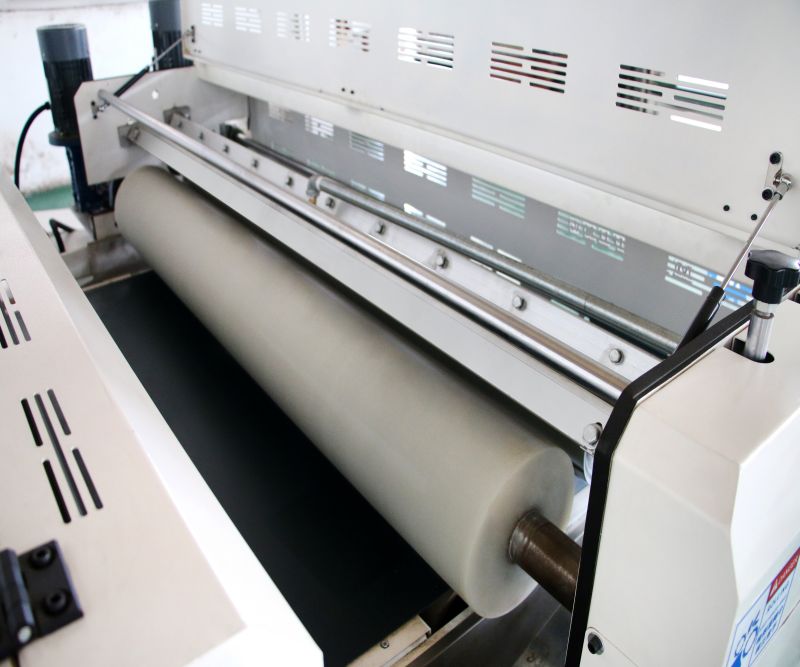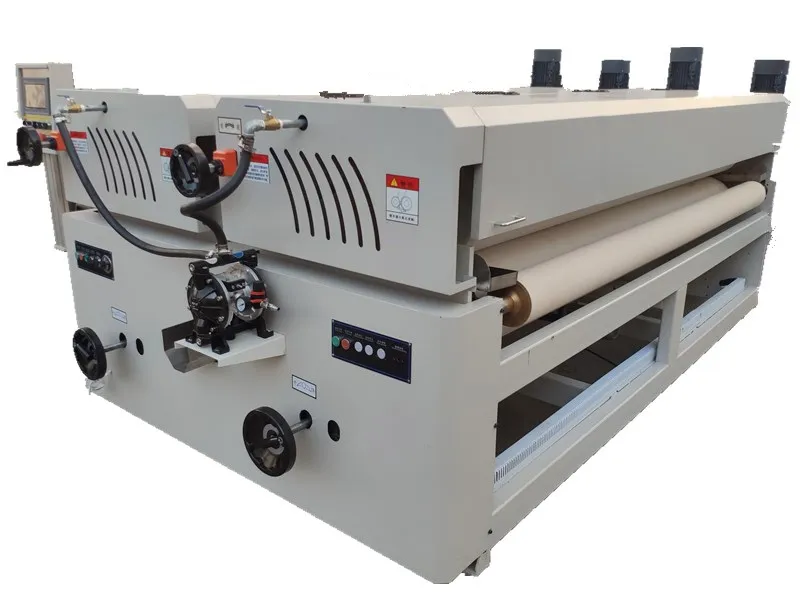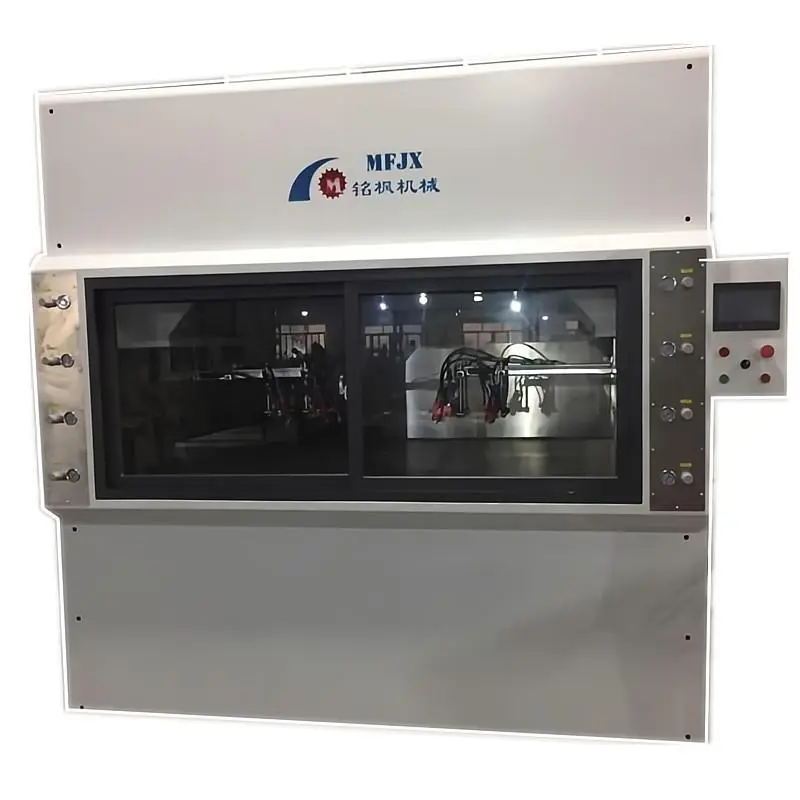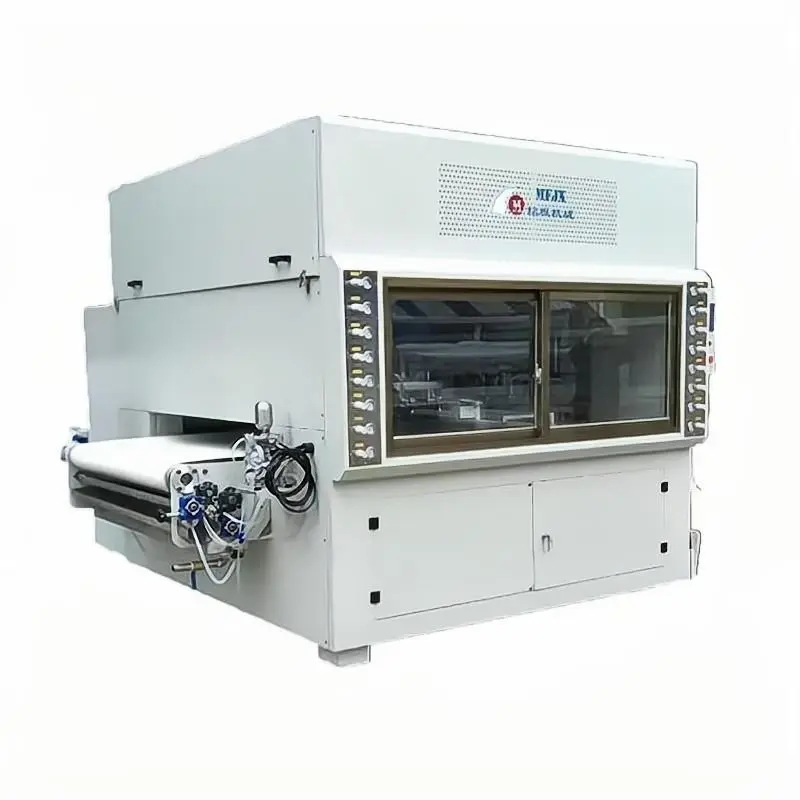Automatic painting machines and roller coating machines are common automated coating equipment used in industries such as furniture manufacturing and decorative panel coating. Although both are industrial surface coating machines, they differ significantly in their operating principles, coating methods, applicable materials, coating results, and paint utilization efficiency.
In actual applications, many companies are concerned about: "Does an automatic painting machine use more paint than a roller coating machine?" This question fundamentally relates to paint consumption efficiency, production cost control, and environmental emissions, providing direct guidance for equipment selection.
This article will analyze in depth the differences in paint usage between the two types of equipment from the following perspectives:
1. Automatic painting machine vs. roller coating machine: Operating principles
2. The impact of coating methods on paint consumption
3. Comparative analysis of paint utilization
4. The role of process flow and coating thickness in determining paint volume
5. System comparison of paint mist loss and overspray
6. Paint compatibility and waste factors
7. Conclusion: Which equipment uses more paint?

Automatic Painting Machine vs. Roller Coating Machine: Working Principles
1. Automatic Painting Machine Principle
An automatic painting machine uses compressed air, airless pressure, or electrostatics to atomize liquid paint and apply it to the workpiece surface. It is typically controlled by multi-axis CNC or reciprocating linear motion, enabling precise, non-contact coating of the workpiece surface.
• Spraying methods: Air spray, air-assisted airless spray, electrostatic spray, etc.
• Nozzle output types: Fan-shaped and circular atomization
• Typical applications: Irregular surfaces, door panel moldings, and three-dimensional edge structures
2. Roller Coating Machine Principle
A roller coating machine uses a rotating metal or rubber roller to transfer paint to the substrate surface in an even, thin film through mechanical contact. Its operating process is a typical contact coating method.
• Coating method: Reverse or forward roller coating
• Coating device: Single roller, double roller, or a combination of multiple rollers
• Typical applications: Flat workpieces such as MDF boards, plywood, and veneer
Comparison: Automatic painting machines utilize a non-contact, spray-based system, while roller coating machines utilize a contact, physical transfer system. This results in distinct differences in paint application efficiency and wear patterns between the two.
The Impact of Painting Methods on Paint Consumption
Different painting methods determine the degree of paint loss during the transfer process:
Coating Methods | Transfer method | Paint Utilization Characteristics |
| Spray coating (automatic painting machine) | Air atomization or airless atomization | Overspray and paint mist diffusion may occur, resulting in low paint utilization |
| Roller coating (roller coating machine) | Mechanical contact transfer | Direct paint transfer with minimal loss |
1. Characteristics of Automatic Painting Machines:
• During the atomization process, paint disperses in the form of fine particles, some of which fail to adhere to the workpiece.
• Overspray can occur, especially when painting corners and irregularly shaped parts.
• Most spray systems have a spray efficiency of 50%-75%, with the remainder discharged as exhaust or recovered by filtration systems.
2. Characteristics of Roller Coating Machines:
• The roller ensures complete contact between the paint and the substrate surface, resulting in a transfer efficiency of 90%-98%.
• There is virtually no atomization or airflow loss.
• What you see is what you get, with losses primarily limited to equipment cleaning and residual material.
Conclusion: Based on the spray method, roller coating machines have significantly higher paint transfer efficiency than automatic painting machines.

Comparative Analysis of Paint Utilization
For ease of comparison, we can summarize the paint utilization rates of the two methods from both theoretical and practical applications:
Items | Automatic painting machine | Roller coating machine |
| Paint atomization loss | High (10-30%) | Very low (<5%) |
| Overspray area loss | High (especially in corners) | None |
| Air-driven waste | Existing | None |
Paint recyclability | Depends on the spray booth system | Easy to collect and reuse |
| Equipment cleaning residue | Medium | Low |
| Overall paint utilization | 50-75% | 90%-98% |
Conclusion: Under the same process requirements and spraying area, the paint volume required by an automatic painting machine is typically 20% to 40% higher than that of a roller coating machine. The fundamental reason for this is the paint transfer method and the inevitable atomization waste during the coating process.

The Impact of Process Flow and Coating Thickness on Paint Quantity
During the coating process, not only does the equipment determine the paint volume, but thickness control during each process also plays a significant role.
1. Automatic painting machine:
• Coating thickness fluctuates significantly, easily overspraying due to changes in spray gun distance or angle.
• Overspraying is often done during operation due to concerns about exposing the base coat, resulting in excessive paint buildup.
• Often used for primer and multiple topcoat processes, increasing total paint consumption.
2. Roller coating machine:
• Precisely controllable coating thickness (via adjustment of the gap between the scraper and roller).
• Accurately controllable thickness within a range of 20-40μm.
• Easily achieves multiple, ultra-thin coatings, reducing paint usage per coat.
Conclusion: Roller coating machines, while maintaining the same functional requirements, can achieve lower paint consumption by precisely controlling coating thickness.
Comparison of Paint Mist Loss and Overspray
1. Common Loss Points in Automatic Painting Machines:
• Diffusion loss caused by air movement during the atomization process
• Overspray on areas outside the workpiece is completely wasted
• Residual spray from the nozzle causes paint buildup at corners and edges each time the spray gun is started and stopped
2. Loss Points in Roller Coating Machines:
• Improper control of roller suction volume, resulting in some paint backflow
• Slight buildup at the edges of the workpiece, but no splashing or diffusion
Conclusion: Automatic painting machines inevitably experience paint mist loss due to their spray characteristics, while roller coating machines are essentially closed-loop coating machines, resulting in minimal loss.
Paint Compatibility and Waste Factors
The compatibility of different paint types with the two types of equipment affects paint utilization efficiency:
Paint Type | Automatic painting machine compatibility | Roller coating machines compatibility | Paint Waste Potential |
| PU paint | High (suitable for spraying) | High | Medium |
| UV paint | High | Very high (most commonly used for roller coating) | Large Losses with Automatic Spraying |
| Water-based paint | Easy to dry, high waste | Drying speed needs to be controlled | High (Spraying) |
| NC paint | Applicable | Applicable | Moderate |
Conclusion: When applying high-cost paints such as UV coatings, roller coating machines minimize waste due to their high transfer efficiency, while automatic painting machines may incur higher costs due to paint mist waste.

Summary: Which machine uses more paint?
——Combining all of the above analysis, we can definitively answer the following:
Under the same production volume and process requirements, an automatic painting machine typically uses 20%-40% more paint than a roller coating machine.
This difference primarily stems from:
• The fundamental difference in paint transfer methods (spraying vs. contact roller coating)
• Air diffusion losses during the atomization process
• Differences in coating thickness control accuracy
• Cleaning residue and adhesion waste determined by the equipment structure
• Paint adaptability and atomization stability
If your company's goal is to reduce paint usage, control coating costs, and minimize emissions, then, provided the workpiece is compatible, a roller coating machine is undoubtedly the more energy-efficient and efficient choice.
However, if the workpiece has an irregular surface, three-dimensional shapes, or requires flexible customization, an automatic painting machine offers greater flexibility. Although it uses more paint, it can achieve the decorative requirements of complex products.
Are your coating machines environmentally friendly and efficient?
Yes. XMF Machinery designs and manufactures environment-friendly, efficient automatic coating production lines, tailored for water-based or other modern coatings. As a conscientious manufacturer and factory, we ensure compliance with environmental regulations while delivering high quality performance.
Customers who purchase our equipment benefit from reduced solvent emissions, energy savings, and lower long-term operating costs—all at low price or under discount promotions.
